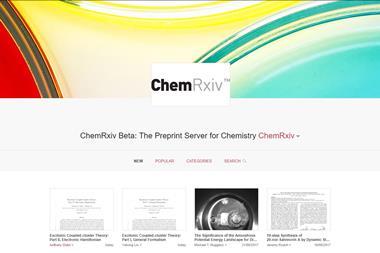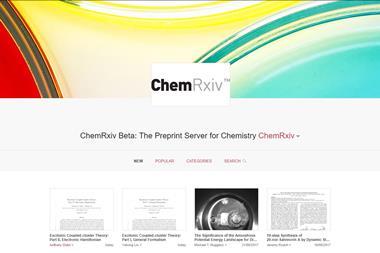A place for chemists to share early results and data before formal peer review
Almost exactly a year after the American Chemical Society (ACS) revealed its plan to build a chemistry preprint server, the organisation has announced that the system is now available in a fully functioning Beta version.
Named ChemRxiv, the free preprint server is patterned after arXiv for physics and bioRxiv for the life sciences, and the ACS announced on 14 August that it is now accepting submissions. The organisation said the Beta version was launched for the chemical science community with ‘initial strategic input’ from the ACS, Royal Society of Chemistry, and German Chemical Society (GDCh), as well as other not-for-profit groups and scientific publishers.
‘With strategic input from the three large chemical societies, other non-profits and publishers, and engagement with other preprint servers, ChemRxiv truly is driven by the chemistry community for the chemistry community,’ says the ACS’ assistant director for open access programmes, Darla Henderson. She says a ‘near future’ goal for ChemRxiv is to finalise the Governance Board and the Scientific Board that will be responsible for overseeing the preprint server’s strategic direction.
The inclusion of the RSC and GDCh in the ChemRxiv development process represents a breakthrough to those who were concerned about the ACS taking the lead in developing this resource, especially because the organisation’s journals have typically not published preprints.
ChemRxiv truly is driven by the chemistry community for the chemistry community
Alan Aspuru-Guzik, a theoretical chemist at Harvard University who works at the interface of chemistry, physics and computer science and is heavily involved with the ACS and RSC, is relieved that ChemRxiv won’t be unilaterally managed by any one organisation. ‘Working together makes lots of sense – preprint servers have to be a collective enterprise,’ he tells Chemistry World. ‘It makes it much more appealing in terms of neutrality and the global aspect – it is not just American-based.’
Overall, Aspuru-Guzik says the fact that ChemRxiv is now operational will significantly speed development of discoveries in the field of chemistry, just as arXiv and bioRxiv have done for their respective disciplines. He is also glad that ChemRxiv won’t be run by a commercial publisher, arguing that international non-profits must be in charge of such a project.
‘In this political climate, the best thing that we can do is join together and show that the world is one,’ says Aspuru-Guzik, who submitted the first two draft papers that were approved and uploaded onto the new preprint server on 15 August.
ChemRxiv includes what the ACS describes as ‘a one-page streamlined submission portal with drag-and-drop file functionality’ through which authors can easily submit preprints in various file formats. All of its content is accessible and can be harvested through an open application programming interface, or via the Open Archives Initiative Protocol for Metadata Harvesting. It will automatically assign digital object identifiers to draft papers to enable accurate attribution of preprints through automatic assignments of and citation tracking. It will also link the final published version of articles with preprints. In addition, Altmetric – a system that tracks the attention that research outputs like scholarly articles and datasets receive online – will track online mentions with each page displaying the associated Altmetric badge and attention score.
A ‘triage process’ is being developed for ChemRxiv that includes checks for plagiarism and other problems, according to the ACS. The aim is to post preprints within one to two business days.
The announcement that the Beta version of ChemRxiv is up and running came less than a week after the news broke that commercial scientific publishing giant Elsevier is launching its own chemistry preprint server.

















1 Reader's comment